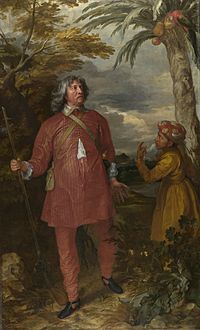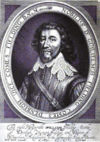William Feilding, 1st Earl of Denbigh facts for kids

William Feilding, 1st Earl of Denbigh (c. 1587 – 8 April 1643, Cannock) was an English courtier. Brother-in- law and close ally of the royal favourite, the Duke of Buckingham, Feilding became involved in major political, military and diplomatic events during the latter part of the reign of James I and under Charles I.
Biography
William Feilding was the son of Basil Fielding of Newnham Paddox in Warwickshire (High Sheriff of Warwickshire in 1612) and of Elizabeth Aston, daughter of Sir Walter Aston (1530–1599).
Feilding matriculated at Emmanuel College, Cambridge in 1603. In 1606 Feilding married Susan, daughter of Sir George Villiers and sister of George Villiers, 1st Duke of Buckingham, who was ennobled as the favourite of King James I. With the rise of Villiers, both Feilding and his wife received various offices and dignities.The historian Gardiner in the nineteenth century described William Feilding as ‘The plain country gentleman who had the good luck to marry Buckingham's sister in the days of her poverty.’
Knighted on 4 March 1607, William Feilding was created Baron and Viscount Feilding in 1620. Two years later he was appointed Master of the Great Wardrobe and Custos Rotulorum of Warwickshire and Earl of Denbigh on 14 September 1622. He attended Prince Charles on the Spanish adventure, served as admiral in the unsuccessful Cadiz Expedition in 1625, and commanded the disastrous attempt upon Rochelle in 1628, becoming the same year a member of the Council of war, and in 1633 a Member of the Council of Wales and the Marches.
In 1631, Lord Denbigh ventured to the East as erstwhile ambassador to the court of Safi of Persia. He visited the East India Company's fledgling Indian possessions where, in 1632, Lord Denbigh met with the Mogul emperor. He returned to England in late 1633.
On 6 July 1641 a barge carrying Feilding, his daughter Elizabeth, Lady Kinalmeaky, Lady Cornwallis, and Anne Kirke capsized while shooting the rapids at London Bridge. Kirke was drowned but the other passengers were rescued.
On the outbreak of the English Civil War he served under Prince Rupert of the Rhine and was present at the Battle of Edgehill. On 3 April 1643 during Rupert's attack on Birmingham he was wounded and died from the effects on the 8th, being buried at Monks Kirby in Warwickshire. His courage, unselfishness and devotion to duty are much praised by Edward Hyde, Earl of Clarendon.
Family
Sir William and his wife, Susan Villiers, had six children:
- Basil Feilding, 2nd Earl of Denbigh (c. 1608–1675)
- George Feilding, 1st Earl of Desmond (c. 1614–1665)
- Lady Mary Feilding (1613–1638), married James Hamilton, 1st Duke of Hamilton.
- Lady Anne Feilding (died 1636), married Baptist Noel, 3rd Viscount Campden
- Elizabeth Feilding, Countess of Guildford (died 1667), married Lewis Boyle, 1st Viscount Boyle.
- Lady Henrietta Marie Feilding (died young)
His daughter, Lady Mary Feilding (1613–1638), also known as Margaret, was married to James Hamilton, 1st Duke of Hamilton, one of the heirs to the throne of Scotland after the descendants of James VI (James I of England). Her portrait was painted by Anthony van Dyck and Henry Pierce Bone. His eldest son, Basil, inherited the title of Earl of Denbigh. His second son, George Feilding, was awarded the right to the title of Earl of Desmond at the same time as his father was made Earl of Denbigh in 1622. George Feilding was around eight years old at the time. Earl of Desmond was a lesser title than Earl of Denbigh, being a title in the Irish, rather than English, peerage.


